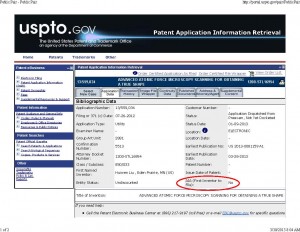Pitfalls of Dealing with AIA Transition Applications
In one of our earlier posts we discussed how to determine whether a given patent application or patent is subject to the First Inventor to File Provisions of the America Invents Act (AIA). In particular, we discussed the complexities involved in determining whether an application filed after March 16, 2013 was subject to the First to Invent regime or the First Inventor to File Regime if it claims priority to an application filed before March 16, 2013 (a “transition application”).
One important aspect of the Patent Office’s Rules for implementing the AIA is that they put the burden on patent applicants to inform the Patent Office if a particular patent application is subject to the First Inventor to File regime. Specifically, if a non- provisional application filed after March 16, 2013 claims the benefit of an application filed before that date and includes any claims with an effective filing date after March 16, 2013, the applicant must so inform the Patent Office within four months of filing the application. The text of the new rule is set forth in 37 CFR 1.78(a)(6) and can be viewed here. If the application does not include such a claim, the applicant does not need to do anything.
This requirement will undoubtedly serve as fodder for inequitable conduct claims for patents issuing from transition applications. In some cases, determining a claim’s effective filing date can be tricky, especially if the earlier priority application discloses a concept broadly but without much detail. In that case, the practitioner will have to make a judgment call as to whether the earlier disclosure is sufficient enough to be enabling. While some may be tempted to adopt a default strategy of identifying patents as subject to First Inventor to File, that may not be advisable. Whether the First Inventor to File or First to Invent scheme is more likely to result in the issuance of a patent may differ in different cases because the First Inventor to File system both restricts and expands the scope of what is prior art in different ways. As a result, incorrectly identifying an application as being subject to the First Inventor to File system may be deemed “material to patentability” because it may exclude prior art that would have otherwise applied under the First to Invent system.
For example, at least as interpreted by the USPTO, the on-sale bar of the AIA only pertains to public sales and excludes those that are private. Fed. Reg. Vol. 78, No. 31 at 11060 (Feb. 14. 2013). In addition, a patent or patent application that is commonly owned with the application under examination may be removed as prior art for anticipation purposes, not merely for obviousness purposes as has been the case under the First to Invent regime. Id. at 11072. Therefore, in some cases it may be arguable that an application was allowed only because it was identified as being subject to the First Inventor to File regime, thus opening the door to a potential inequitable conduct claim if the identification was incorrect.
The Patent Office has made it easy to identify applications as being subject to the First Inventor to File regime by including a check box on the Application Data Sheet form for making the identification. In addition, PAIR has been revised to indicate whether a particular application is subject to the First Inventor to File or First to Invent regime as illustrated below (click on the image to enlarge):
It may be advisable to document the reasoning behind identifying (or not identifying) a particular transition application as being subject to the First Inventor to File Regime. This will help establish that there was no intent to deceive the Patent Office if an application is erroneously identified (or not identified) as being subject to the First Inventor to File regime. It is unclear whether and to what extent examiners will independently try to determine the prior art regime that is applicable to a particular application. Thus far, the PTO has stated that it “does not plan to provide a specific explanation in an Office action of why the pre AIA first to invent provisions or the AIA first inventor to file provisions apply to an application unless the matter is called into question”. Id. at 11061. The PTO has also indicated that it plans to have staff in each Technology Center to assist in determining whether an application is subject to the First Inventor to File system and that an appeal would ultimately be required to resolve a dispute between an examiner and application as to which regime applies. Id.

